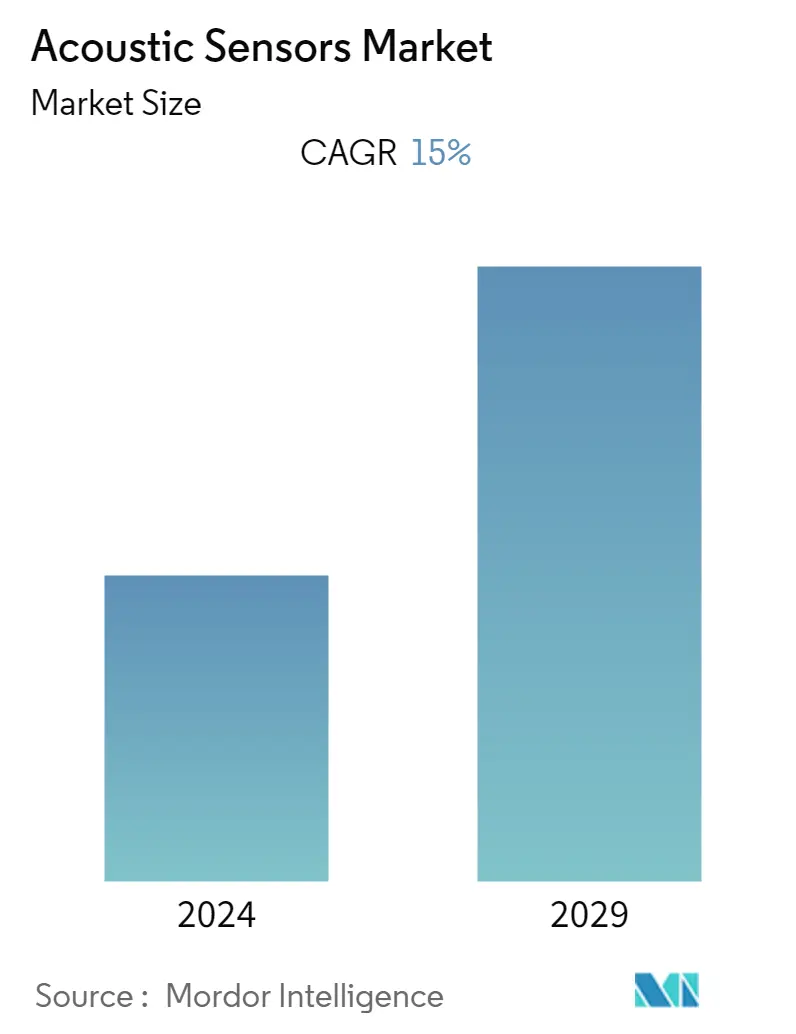Market Size of Acoustic Sensors Industry

| Study Period | 2019 - 2029 |
| Base Year For Estimation | 2023 |
| CAGR | 15.00 % |
| Fastest Growing Market | Asia Pacific |
| Largest Market | North America |
| Market Concentration | Low |
Major Players
*Disclaimer: Major Players sorted in no particular order |
Need a report that reflects how COVID-19 has impacted this market and its growth?
Acoustic Sensors Market Analysis
The Acoustic Sensors Market is expected to grow at a CAGR of 15% during the forecast period. The surface wave acoustic sensor is expected to have high growth during the forecast period due to its implementation in television transmitters and radios to generate signals for broadcasting. SAW devices are indispensable as filters in radio frequency applications and are important components used in the terminals and base stations for satellite communication.
- Over the last few years, surface acoustic wave (SAW) technology was significantly adopted across some industry applications, including aerospace, telecommunication, and automotive. The most common use is in electronic components known as SAW filter, a basic radio frequency (RF) circuits component. SAW devices are utilized to measure humidity, pressure, and temperature and detect certain chemicals.
- Furthermore, acoustic sensors have recently seen significant demand in automotive applications. The complete silence of the motors used in electric cars may pose a hazard to inattentive pedestrians. As a result, the new electric and hybrid vehicles will have to be equipped with an acoustic warning system. Therefore, rising concerns regarding traffic management will drive market growth.
- Further, 5G is likely to create a massive opportunity for the vendors in the market studied to expand their scope, as the world's leading wireless technology innovators push the boundaries of what is possible in mobile technology. With growing filter content in 5G designs, OEM customers are focusing on the attractive combination of higher filter performance, and lower-cost SAW technology. Presently, there are many types of filters, including multilayer ceramic filters, monolithic ceramic filters, acoustic filters, and cavity filters. In smartphone RF front-ends, acoustic filters are mainly used, including SAW filters and BAW filters.
- In the initial phase of COVID-19, the studied market witnessed a disruption in the supply chain owing to a nationwide lockdown and closure of many manufacturing capacities. The healthcare industry expanded the opportunity scope for acoustic sensor technology vendors. Canada-based Research Nova Scotia developed a technology platform to test for the virus using surface acoustic wave (SAW) biosensors. It helped eliminate the need for reagents, sample processing, and specialized personnel. The SAW biosensors can detect very low concentrations and be manufactured from cheap and locally available material. To further contribute to the efforts of the Canadian government and the Province of Nova Scotia to address the COVID-19 outbreak, Research Nova Scotia (RNS) continues to provide rapid response funding from its Research Opportunities Fund. This fund was created by the Province of Nova Scotia to enable RNS to provide financial support to research projects that have the potential to benefit Nova Scotians.
